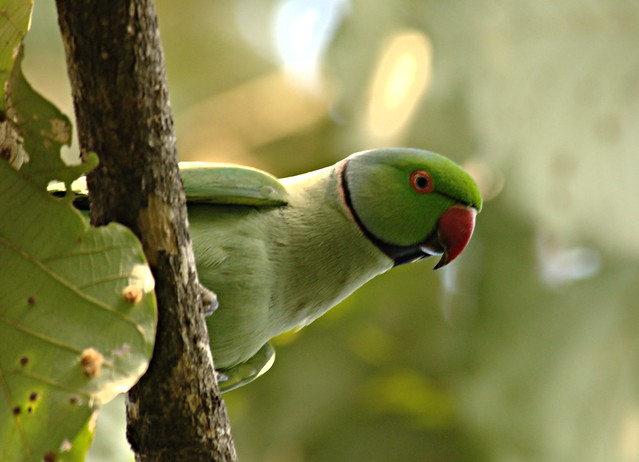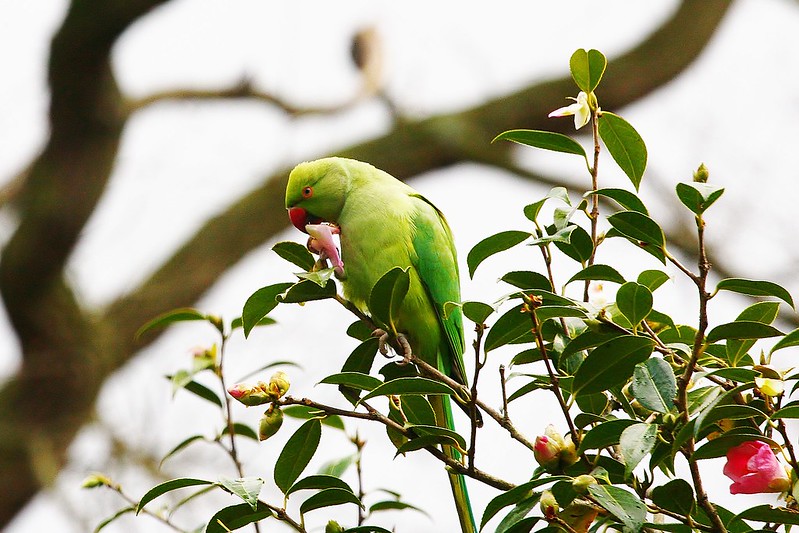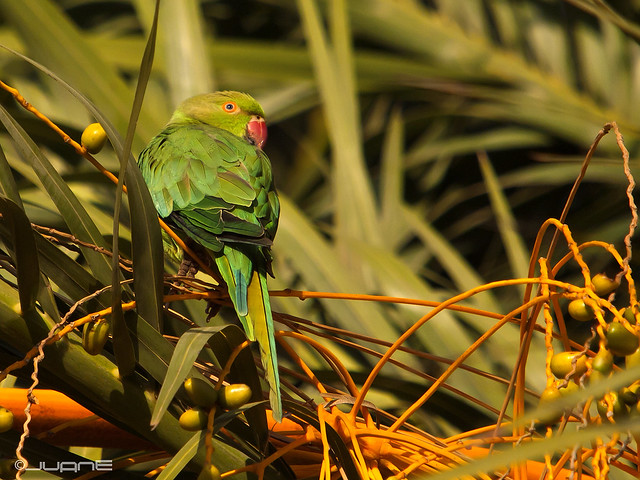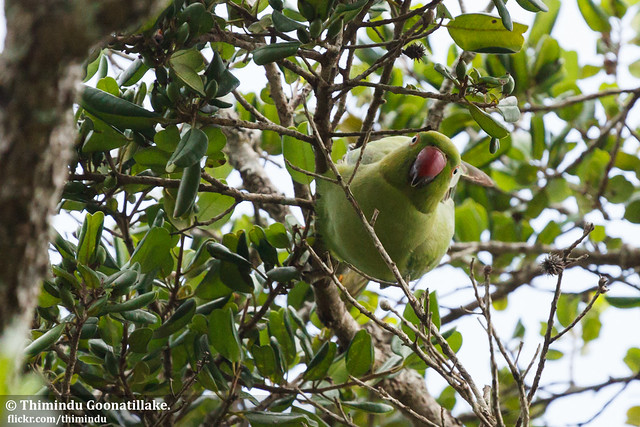The Rose-ringed Parakeet, from the parrot family (Psittacidae), is the most widespread exotic bird in Europe and Asia. It comes from central Africa (from Mauritania to Somalia) and south Asia (Pakistan, Nepal, India, Sri Lanka, Bangladesh, Myanmar and southeast China). It is a medium-sized bird, about 43 centimetres long including its long tail of 15 centimetres, with a short reddish hooked beak and yellowish green plumage. It has a wingspan of about 50 centimetres.
It is easy to distinguish between the sexes because males have a black and pink collar around their neck. Juveniles don’t have this collar either, their iris is light grey and their beak is pale pink. Adult plumage usually appears after 18 months of life, being complete at 32 months old.

Rose-Ringed Parakeet (Psittacula krameri) | Author: Joby Joseph · Creative Commons: Attribution 2.0 Generic
This bird is very noisy, as well as gregarious or sociable, and lives in mixed groups of twelve to fifteen specimens, although thousands of them can reunite in perches or feeding areas. It inhabits open zones, bush savannahs and not very thick forests in its natural distribution area. They set their nests in the natural hollows of the trees, in Woodpecker nests or even in buildings’ cavities or ceilings.
The Rose-ringed Parakeet is not a migratory bird, although it can carry out some movements depending on the availability of food or harvests. Its unnatural expansion towards other countries has been caused by the continuous escapes and intentional releases, given that it is a species that has been traditionally commercialised as a pet. In the city parks they have found a similar habitat to that of their regions of origin, as well as the possibility of finding easy food.

Rose-Ringed Parakeet (Psittacula krameri) | Author: Adrian Scottow · Creative Commons: Attribution 2.0 Generic
In Europe, the Rose-ringed Parakeet can be found in the United Kingdom, France, the Netherlands, Belgium, Austria, Germany, Slovenia, Spain, Turkey and Italy. Although the first breeding of this bird in Europe dates back to 1855, it wasn’t until 1969 when the first registers of Rose-ringed Parakeets in freedom in the UK were documented. In 1983, they were estimated to expand between 500 and 1000 specimens, mostly due to the generalised use of artificial feeders, which prevented them from dying during the winter.
Rose-ringed Parakeets usually prefer coastal climate. In Spain, this is the most abounding species in the coast, nesting in the provinces of Barcelona (between 80 and 100 couples), Valencia (between 34 and 37 couples) and Malaga (between 37 and 45 couples). There are also references in Castellon, Alicante, Murcia, Almeria or Granada, and in the archipelagos: Mallorca, Gran Canaria, Tenerife and Fuerteventura, although it is also largely distributed in the centre of the peninsula.

Rose-Ringed Parakeet (Psittacula krameri) | Author: JuanE · Creative Commons: Attribution 2.0 Generic
The Rose-ringed Parakeet is an invasive exotic species, and it is listed as such both on international level in the database of the Invasive Species Specialist Group (ISSG), created in the Species Survival Commission (SSC) of the IUCN, and in the European and Spanish legislation, among others.
The Spanish Catalogue of Exotic Invasive Species forbids the possession, transportation, trafficking and commerce of the Rose-ringed Parakeet. The only specimens excluded are those purchased before the entry into force of the Royal Decree 630/2013, where this prohibition is regulated.
Why is the Rose-ringed Parakeet an invasive species?
It is considered an exotic invasive species because it is a bird that spreads at a great speed on a new territory, altering the structure and functioning of ecosystems and causing ecological, socioeconomic and health damage.
Among the impact and threats caused by the Rose-ringed Parakeet we can find modifications in the vegetation. It affects palm trees, plane trees (Platanus hybrida), white poplars (Populus alba) and also rubber trees (Coussapoa dealbata).

Rose-Ringed Parakeet (Psittacula krameri) | Author: Thimindu Goonatillake · Creative Commons: Attribution 2.0 Generic
It also causes a tough competition for nests with bats, nocturnal birds of prey (especially with the Scops Owl) and Woodpeckers. Moreover, they compete for the food with native species as the blackbird, the Eurasian Blackcap and other birds that feed on grain or fruit.
The Rose-ringed Parakeet can occasionally cause important damage to crops, as occurred in Pakistan and India. In farming areas they can reduce the harvest of rice, maize, millet, fruit trees or coffee plants, and they even feed on stored grain.
There is also the possibility of transmitting psittacosis to the human population: this is a characteristic disease in parrots, turkeys and pigeons.
National census of the Rose-ringed Parakeet
Despite of the fact that the Spanish Law of Natural Heritage and Biodiversity (2007) compels autonomous communities to carry out measures for the monitoring and control of invasive species, practically none of them has an appropriate programme for that purpose. For this reason, the Spanish Ornithological Society has started a campaign to carry out the first national census of both Rose-ringed Parakeet and Monk Parakeet, with the aim of knowing the size and distribution of its populations.
The census of the Monk Parakeet was carried out during the month of March. Now that summer arrives, they will start with the census of the Rose-ringed Parakeet. We encourage you all to participate in this census through Twitter. You just have to indicate the city and street where Rose-ringed Parakeets can be found with the hashtag #AquíCotorra.
The European expansion of the Rose-ringed Parakeet brings to light how dangerous it is to release exotic species in an environment different to that of their origin. Society and authorities should be more conscious of this danger, and think very carefully about the consequences of commercialising exotic species.











